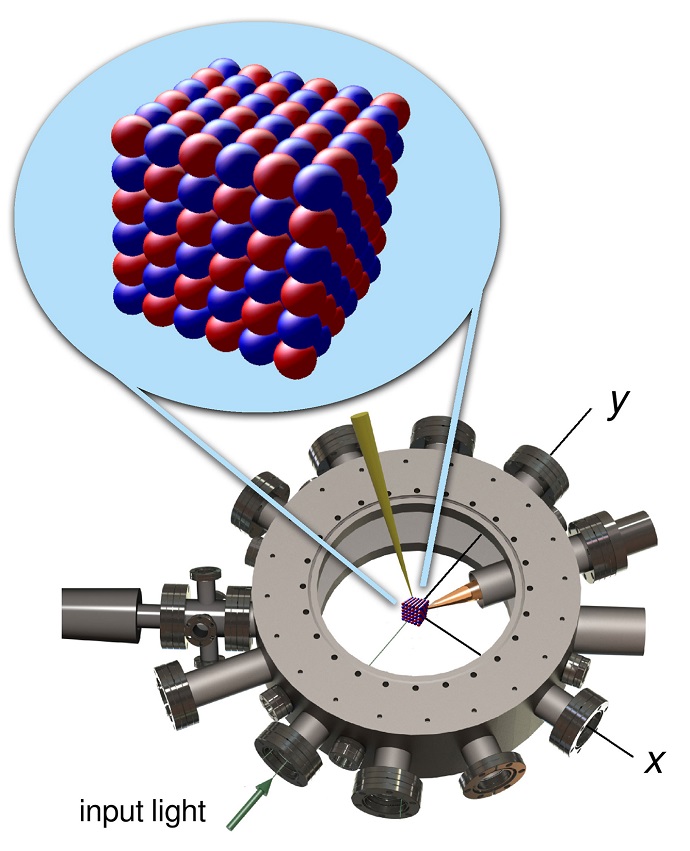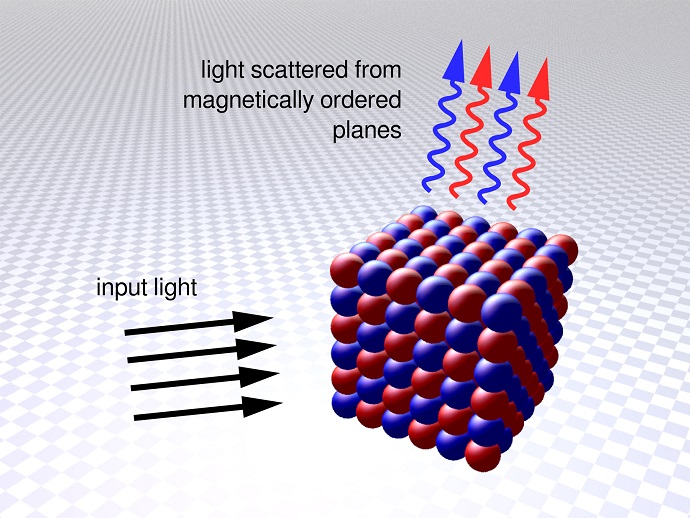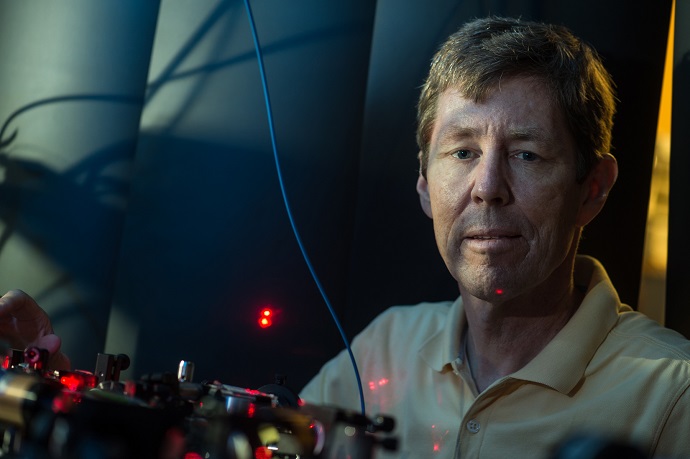HOUSTON — (Feb. 23, 2015) — Using ultracold atoms as a stand-in for electrons, a Rice University-based team of physicists has simulated superconducting materials and made headway on a problem that’s vexed physicists for nearly three decades.
The research was carried out by an international team of experimental and theoretical physicists and appears online this week in the journal Nature. Team leader Randy Hulet, an experimental physicist at Rice, said the work could open up a new realm of unexplored science.
Nearly 30 years have passed since physicists discovered that electrons can flow freely through certain materials — superconductors — at relatively elevated temperatures. The reasons for this high-temperature, or “unconventional” superconductivity are still largely unknown. One of the most promising theories to explain unconventional superconductivity — called the Hubbard model — is simple to express mathematically but is impossible to solve with digital computers.
“The Hubbard model is a set of mathematical equations that could hold the key to explaining high-temperature superconductivity, but they are too complex to solve — even with the fastest supercomputer,” said Hulet, Rice’s Fayez Sarofim Professor of Physics and Astronomy. “That’s where we come in.”
Hulet’s lab specializes in cooling atoms to such low temperatures that their behavior is dictated by the rules of quantum mechanics — the same rules that electrons follow when they flow through superconductors.
“Using our cold atoms as stand-ins for electrons and beams of laser light to mimic the crystal lattice in a real material, we were able to simulate the Hubbard model,” Hulet said. “When we did that, we were able to produce antiferromagnetism in exactly the way the Hubbard model predicts. That’s exciting because it’s the first ultracold atomic system that’s able to probe the Hubbard model in this way, and also because antiferromagnetism is known to exist in nearly all of the parent compounds of unconventional superconductors.”
Hulet’s team is one of many that are racing to use ultracold atomic systems to simulate the physics of high-temperature superconductors.
“Despite 30 years of effort, people have yet to develop a complete theory for high-temperature superconductivity,” Hulet said. “Real electronic materials are extraordinarily complex, with impurities and lattice defects that are difficult to fully control. In fact, it has been so difficult to study the phenomenon in these materials that physicists still don’t know the essential ingredients that are required to make an unconventional superconductor or how to make a material that superconducts at even greater temperature.”
Hulet’s system mimics the actual electronic material, but with no lattice defects or disorder.
“We believe that magnetism plays a role in this process, and we know that each electron in these materials correlates with every other, in a highly complex way,” he said. “With our latest findings, we’ve confirmed that we can cool our system to the point where we can simulate short-range magnetic correlations between electrons just as they begin to develop.
“That’s significant because our theoretical colleagues — there were five on this paper — were able to use a mathematical technique known as the Quantum Monte Carlo method to verify that our results match the Hubbard model,” Hulet said. “It was a heroic effort, and they pushed their computer simulations as far as they could go. From here on out, as we get colder still, we’ll be extending the boundaries of known physics.”
Nandini Trivedi, professor of physics at Ohio State University, explained that she and her colleagues at the University of California-Davis, who formed the theoretical side of the effort, had the task of identifying just how cold the atoms had to be in the experiment.
“Some of the big questions we ask are related to the new kinds of ways in which atoms get organized at low temperatures,” she said. “Because going to such low temperatures is a challenge, theory helped determine the highest temperature at which we might expect the atoms to order themselves like those of an antiferromagnet.”
After high-temperature superconductivity was discovered in the 1980s, some theoretical physicists proposed that the underlying physics could be explained with the Hubbard model, a set of equations invented in the early 1960s by physicist John Hubbard to describe the magnetic and conduction properties of electrons in transition metals and transition metal oxides.
Every electron has a “spin” that behaves as a tiny magnet. Scientists in the 1950s and 1960s noticed that the spins of electrons in transition metals and transition metal oxides could become aligned in ordered patterns. In creating his model, Hubbard sought to create the simplest possible system for explaining how the electrons in these materials responded to one another.
The Hubbard model features electrons that can hop between sites in an ordered grid, or lattice. Each site in the lattice represents an ion in the crystal lattice of a material, and the electrons’ behavior is dictated by just a handful of variables. First, electrons are disallowed from sharing an energy level, due to a rule known as the Pauli Exclusion Principle. Second, electrons repel one another and must pay an energy penalty when they occupy the same site.
“The Hubbard model is remarkably simple to express mathematically,” Hulet said. “But because of the complexity of the solutions, we cannot calculate its properties for anything but a very small number of electrons on the lattice. There is simply too much quantum entanglement among the system’s degrees of freedom.”
Correlated electron behaviors — like antiferromagnetism and superconductivity — result from feedback, as the action of every electron causes a cascade that affects all of its neighbors. Running the calculations becomes exponentially more time-consuming as the number of sites increases. To date, the best efforts to produce computer simulations of two- and three-dimensional Hubbard models involve systems with no more than a few hundred sites.
Because of these computational difficulties, it has been impossible for physicists to determine whether the Hubbard model contains the essence of unconventional superconductivity. Studies have confirmed that the model’s solutions show antiferromagnetism, but it is unknown whether they also exhibit superconductivity.
In the new study, Hulet and colleagues, including postdoctoral researcher Russell Hart and graduate student Pedro Duarte, created a new experimental technique to cool the atoms in their lab to sufficiently low temperatures to begin to observe antiferromagnetic order in an optical lattice with approximately 100,000 sites. This new technique results in temperatures on the lattice that are about half of that obtained in previous experiments.
“The standard technique is to create the cold atomic gas, load it into the lattice and take measurements,” Hart said. “We developed the first method for evaporative cooling of atoms that had already been loaded in a lattice. That technique, which uses what we call a ‘compensated optical lattice,’ also helped control the density of the sample, which becomes critical for forming antiferromagnetic order.”
Hulet said a second innovation was the team’s use of the optical technique called Bragg scattering to observe the symmetry planes that are characteristic of antiferromagnetic order.

Rice University physicists trapped ultracold atomic gas in grids of intersecting laser beams to mimic the antiferromagnetic order observed in the parent compounds of nearly all high-temperature superconductors.
CREDIT: P. Duarte/Rice University
He said the team will need to develop an entirely new technique to measure the electron pair correlations that cause superconductivity. And they’ll also need colder samples, about 10 times colder than those used in the current study.
“We have some things in mind,” Hulet said. “I am confident we can achieve lower temperatures both by refining what we’ve already done and by developing new techniques. Our immediate goal is to get cold enough to get fully into the antiferromagnetic regime, and from there we’d hope to get into the d-wave pairing regime and confirm whether or not it exists in the Hubbard model.”

Researchers used the optical technique called Bragg scattering to observe the symmetry planes that are characteristic of anti-ferromagnetic order.
CREDIT: P. Duarte/Rice University
Additional co-authors include Tsung-lin Yang and Xinxing Liu, all of Rice; Thereza Paiva of Universidade Federal do Rio de Janeiro; Ehsan Khatami of both the University of California-Davis (UC-Davis) and San Jose State University; Richard Scalettar of UC-Davis; and David Huse of Princeton University. The research at Rice was supported by the Defense Advanced Research Projects Agency, the National Science Foundation, the Robert Welch Foundation and the Office of Naval Research.
A copy of the Nature study is available at:
http://dx.doi.org/10.1038/nature14223













